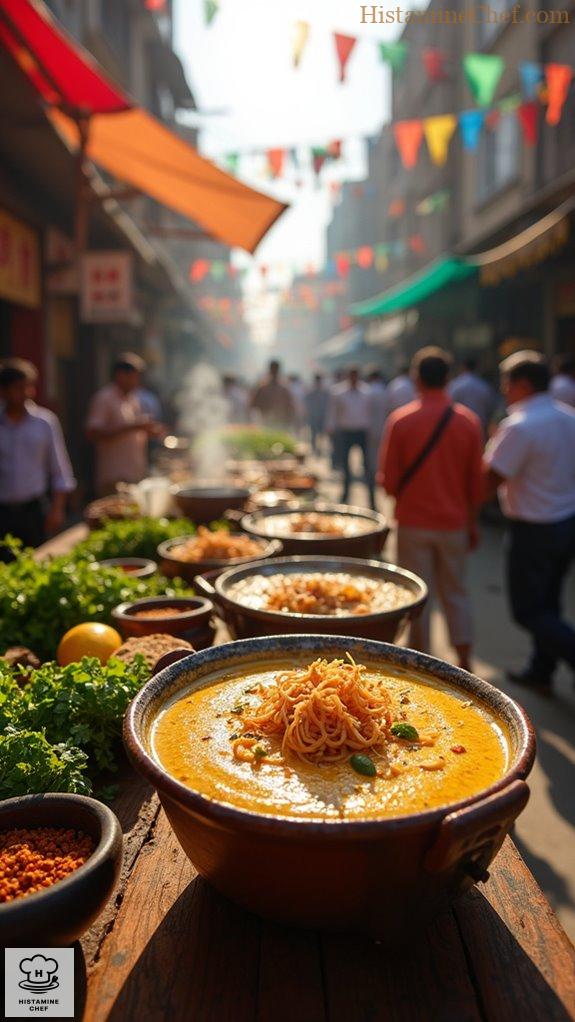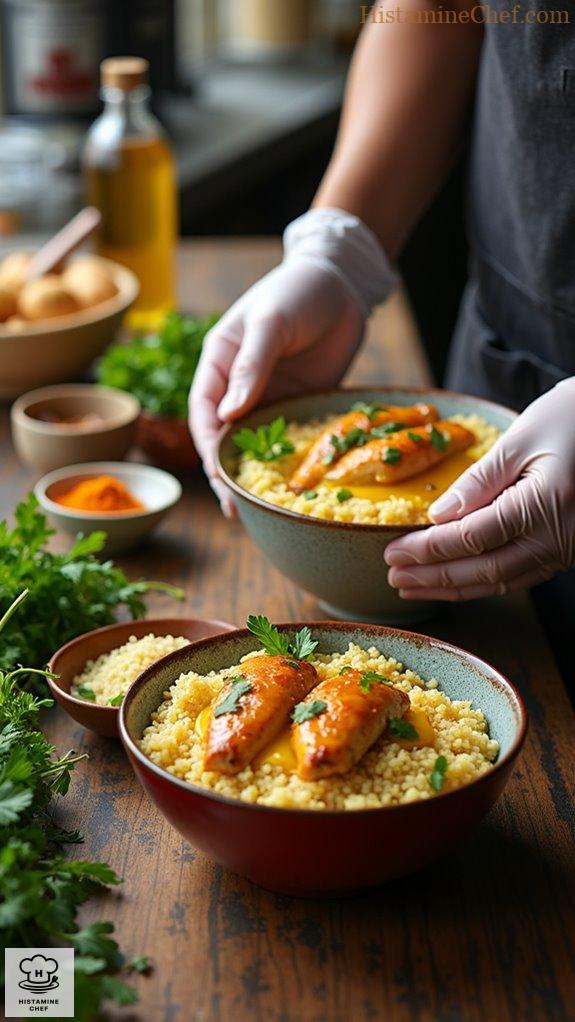Ever tasted Karachi’s heavenly homemade haleem? Imagine this: slow-cooked goodness bursting with flavors, where lentils meet tender chicken and spices dance a merry jig. But wait, are you worried about histamines? Fear not! I’ve swapped out traditional ingredients for fresh, low-histamine alternatives like quinoa and turmeric. It’s comfort food minus the baggage! Curious to know how I transform this street food classic while keeping it light on your stomach? Let’s explore this culinary journey together!
Cultural Hub of Karachi

The street food culture of Karachi is a vibrant reflection of the city’s rich cultural tapestry, rooted in its diverse ethnic composition. As a melting pot of Mohajirs, Sindhis, Baloch, Pashtuns, and others, the city’s street food scene showcases a fusion of flavors and culinary techniques from various regions. Among the most beloved offerings is homemade haleem, a thick, savory dish made from a blend of wheat, barley, lentils, and tender meat, slow-cooked to perfection. The tradition of street food in Karachi dates back to its early days, when vendors began serving quick, affordable meals to the bustling populace, particularly in areas like Saddar and Clifton. Karachi’s ancient port cities influenced trade and the exchange of culinary traditions, contributing to the evolving street food landscape. The influence of its colonial past introduced elements of British and Indian cuisines, further enriching the palate. Today, street food in Karachi is essential for social gatherings, festivals, and everyday life, with homemade haleem often enjoyed during Ramadan and special occasions. The ambiance of bustling streets, the aroma of spices, and the communal experience of sharing meals contribute to Karachi’s identity as a dynamic cultural hub and the heartbeat of its culinary life.
Slow-Cooked in Large Cauldrons

Street vendors prepare homemade haleem by slowly cooking it in large cauldrons under open heat.
First, they combine finely chopped meat (usually beef or mutton) with a mix of lentils, crushed wheat, and barley in the cauldron. The mixture is then generously seasoned with spices, and enough water or stock is added to initiate the simmering process.
Throughout the cooking period, which can last over eight hours, vendors stir the contents regularly to guarantee even cooking and to prevent sticking. They closely monitor the temperature, adjusting the heat as necessary to maintain a low simmer, allowing the ingredients to meld and break down properly, enriching the dish with depth of flavor.
Finally, ghee or oil is stirred in before serving, while fried onions and herbs are sprinkled on top for added texture and aroma.
Ingredients Needed:
- 1 kg beef or mutton (cut into pieces)
- 200 g mixed lentils (such as moong and urad)
- 200 g crushed wheat
- 200 g barley
- 4 liters water or stock
- 3 tablespoons of spices (e.g., cumin, coriander, garam masala)
- 100 ml ghee or oil
- Toppings: fried onions and chopped herbs
Cooking Steps:
- Combine meat, lentils, and grains.
- Add spices and water or stock.
- Place cauldron over heat source.
- Stir regularly to prevent sticking.
- Monitor temperature for low simmer.
- Cook for over eight hours.
- Stir in ghee or oil before serving.
- Top with fried onions and herbs.
Slow Cook With Fresh Ingredients

To make Homemade Haleem, start by soaking cracked wheat and lentils overnight for better texture.
In a heavy pot, sauté diced allowed vegetables like carrots and potatoes in coconut oil, adding spices like turmeric if desired.
Incorporate soaked grains, water, and cubed fresh chicken or duck.
Slow cook for several hours, stirring occasionally, allowing flavors to meld.
Finally, blend if you prefer a creamy consistency, adjust seasoning with salt, and garnish with fresh herbs before serving.
- Soak cracked wheat overnight
- Use fresh chicken or duck
- Sauté allowed vegetables
- Add turmeric for flavor
- Slow cook for several hours
- Blend for creamy texture
- Garnish with fresh herbs
Low Histamine Variation of Haleem

Histamine intolerance can greatly limit one’s food choices, especially when it comes to street food, which often contains a variety of high-histamine and liberating ingredients.
Street foods are typically prepared in bulk, using ingredients that may not meet the dietary restrictions of those with histamine sensitivity. Therefore, it’s essential to be mindful of what goes into these dishes to avoid triggering uncomfortable symptoms.
Eating street food like Haleem poses several problems for individuals with histamine intolerance. Many common ingredients, such as canned beans and spices like cumin or chili powder, are on the restricted list due to their potential to release histamine or contain high levels of it, as outlined by the SIGHI list.
Furthermore, street food often includes processed meats and fermented items, which are prohibited for those with sensitivities. Finally, the inability to control ingredient freshness and preparation methods can increase the risk of exposure to histamines. Additionally, avoiding high-histamine foods can significantly improve overall health outcomes for those with histamine sensitivity.
Low Histamine Variation of Haleem Cooking Instructions:
- Replace canned legumes with freshly cooked millet or quinoa for base grains.
- Use freshly cooked chicken or turkey instead of processed or preserved meats.
- Omit onions and garlic; flavor with fresh herbs, such as parsley or cilantro.
- Substitute high-histamine spices with safe alternatives like turmeric and ginger.
- Avoid any fermented sauces; use apple vinegar for mild acidity instead.
- Use clarified butter or coconut oil instead of oils classified as restricted.
- Ensure meat is cooked fresh, avoiding any delay to limit histamine build-up.
- Skip traditional additives; rely solely on allowed sweeteners like honey if needed.
- Serve with a side of allowed vegetables, such as steamed zucchini or carrots.
- Maintain strict hygiene during preparation to prevent cross-contamination and spoilage.
Video Summary
Haleem, a beloved dish from the Indian subcontinent, showcases a rich tapestry of flavors and textures. Today, we’ll explore two versions of this delicious meal: the authentic street vendor style and a home-friendly, low histamine alternative, which we’ll describe later.
Street vendors typically start with a perfect blend of wheat, lentils, and meat. They soak the wheat overnight for ideal texture. A thick pot or handi is then heated over open flames.
Freshly chopped onions are often sautéed until golden brown. Then, they add minced ginger and garlic for a robust flavor. The meat is added next, often marinated with spices like cumin and curry powder. Vendors meticulously stir the mixture, blending it to a smooth consistency. They also add water, letting it simmer for hours. The cooking time allows the ingredients to meld beautifully.
Finally, garnished with fried onions and fresh coriander, it’s served hot and aromatic.
To make a home-friendly, low histamine version, start with soaked wheat. Replace lentils with allowed alternative grains like quinoa. Skip the onions and use chives or green onions for flavor instead. Choose fresh chicken or turkey, and avoid marinating in spicy ingredients. Use distilled white vinegar instead of any acidic elements.
Cook everything in a thick pot, stirring consistently over low heat. Add water gradually to achieve the desired consistency, simmering it patiently.
Garnish your dish simply with fresh coriander and enjoy its hearty taste. The final meal looks creamy and inviting, bursting with wholesome flavors. Click the link in the description for the full recipe!
References
- https://en.wikipedia.org/wiki/History_of_Karachi
- https://www.thewander.travel/blog/karachi-and-sindh-highlights
- https://kda.gos.pk/contents/?id=14
- https://lithub.com/understanding-pakistan-through-the-story-of-karachi/
- https://www.dawn.com/news/1863555
- https://www.teaforturmeric.com/easier-slow-cooker-haleem-pakistani-beef-and-lentil-stew-gluten-free/
- https://kitchenofdebjani.com/2018/05/hyderabadi-haleem-recipe/
- https://www.thedeliciouscrescent.com/haleem-recipe/
- https://untoldrecipesbynosheen.com/easy-pakistani-beef-haleem-recipe/
- https://tastecooking.com/break-rules-blend-lamb/


Leave a Reply